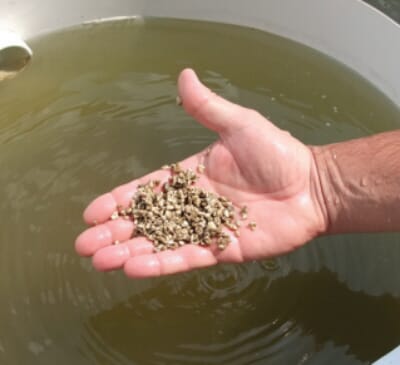Cryogenic freezing is a process often used on high-end food products to quickly freeze the commodity while maintaining superior quality over other freezing techniques. More importantly, cryogenic freezing can effectively eliminate the Vibrio vulnificus bacteria sometimes found in oyster meat that can sicken human consumers who have compromised immune systems.
“The steam venting technology features pressurised steam in the package, compared to traditional vacuum packaging techniques,” noted Mr Sathivel. As moisture in the meal evaporates and creates steam, the steam helps retain product moisture. The package self-opens to regulate the pressure so there’s no need to poke holes for ventilation. The process was designed for and has been applied in the frozen food industry to help extend shelf life while maintaining a premium product.
Mr Sathivel, the principal investigator on this Louisiana Sea Grant funded project, is working with colleagues at LSU and doctoral student Luis Espinoza. In 2011, the Louisiana Gulf Coast Section of the Institute of Food Technologies (IFT) awarded Espinoza the Central Analytical Laboratory Scholarship for his work on the development of oyster products. Mr Espinoza was also awarded first place in the 2010 IFT-Refrigerated and Frozen Foods Division graduate student paper competition for “Effect of Cryogenic and Air Blast Freezing on Pathogenic Bacteria Load Associated with Oysters and the Quality of Oyster Meat.”
The frozen oyster meal project, which began in September 2010, was delayed because of the Deepwater Horizon oil spill. Oysters were unavailable following the spill, which caused the expected completion date to be pushed back to February 2013. Sathivel would eventually like to investigate using other coastal products for frozen ready-meals. “The ready-meal products will be evaluated for nutritional and chemical properties, microbial safety, product acceptance and production cost,” added Mr Sathivel.
Oyster Nurseries in the Industry’s Future Oyster growers, like terrestrial farmers, need seed. Historically, Louisiana oyster harvesters have relied on wild larvae and seed collected from public waters that they transplant onto private leases for grow-out. But natural predation, hurricanes, as well as freshwater diversions like those in 2010 to combat the BP oil spill, negatively affect wild seed production. Future coastal restoration efforts utilizing additional diversions, plus piped-in sediment to bolster shorelines, are expected to further diminish wild seed manufacture.

Hatcheries are the solution to current and coming oyster seed needs, according to John Supan, Louisiana Sea Grant (LSG) molluscan shellfish specialist. “Wild seed will never entirely go away,” said Mr Supan, “but the days when Louisiana oyster growers will pick up the phone to a hatchery and place an order for cultivated seed oysters aren’t far off.”
Since 1990, LSG has operated a hatchery on Grand Isle focused on improving the state’s oyster production through research and technology transfer. Caminada Bay Oyster Co.’s Jules Melancon is one of the state’s oystermen to benefit from LSG’s “nursery-development” research.
Under Mr Supan’s guidance, Mr Melancon has built his own oyster nursery on Grand Isle to utilize the larvae produced from the Sea Grant facility. Melancon’s nursery is the first such public/private partnership for LSG, and there are hopes for many other similar relationships in the future. “Jules is producing oyster seed for his needs,” said Mr Supan, “but there are opportunities for home-grown commercial nurseries to supply Louisiana oyster growers.”
Existing bait fish and shrimp, as well as crab shedding operations, can easily expand to produce oyster seed. “The infrastructure is already there,” said Mr Supan. “They have tanks. They have the plumbing and pumps. They have direct access to saline water. It’s a natural extension of their existing business and a means of keeping Louisiana a predominant oyster producing state.”
Working with LSG Extension personnel, Mr Supan is identifying appropriate locations and potential partners for this next phase of his work. He and Bill Walton from Auburn University are also teaching Gulf of Mexico harvesters the advantages of growing oysters in mesh bags suspended in the water column, rather than on traditional shell reefs in open water. This off-bottom technique protects the oysters from predators and reduces disease and fouling.
“One of my graduate students conducted an industry survey and found only 35 per cent of the oysters planted using traditional methods make it to harvest,” said Mr Supan. “With off-bottom culture, every oyster you put into the water you get back.” He and Walton are conducting workshops on the off-bottom technique as well as other oyster-related topics through 2012.


